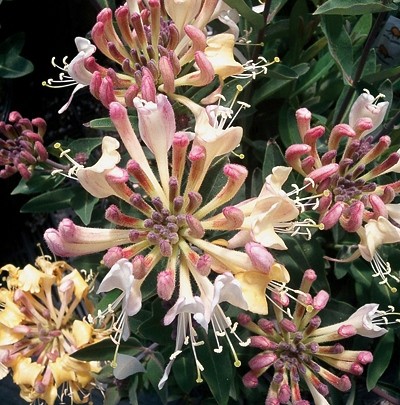European honeysuckle
(Lonicera confusa)

Description
Lonicera periclymenum, common names honeysuckle, common honeysuckle, European honeysuckle, or woodbine, is a species of flowering plant in the family Caprifoliaceae native to much of Europe, North Africa, Turkey and the Caucasus. It is found as far north as southern Norway and Sweden. Growing to 7 m (23 ft) or more in height, it is a vigorous deciduous twining climber, occasionally keeping its old leaves over winter. In the UK it is one of two native honeysuckles, the other being Lonicera xylosteum. It is often found in woodland or in hedgerows or scrubland. The tubular, two-lipped flowers, creamy white or yellowish in colour, may be flushed with pink or red on the outside and in bud, and are carried in showy clusters at the ends of the shoots. The flowers are highly scented by night, much less so by day. Honeysuckles are arching shrubs or twining vines in the family Caprifoliaceae, native to northern latitudes in North America and Eurasia. Approximately 180 species of honeysuckle have been identified in North America and Eurasia. Widely known species include Lonicera periclymenum (common honeysuckle or woodbine), Lonicera japonica (Japanese honeysuckle, white honeysuckle, or Chinese honeysuckle) and Lonicera sempervirens (coral honeysuckle, trumpet honeysuckle, or woodbine honeysuckle). L. japonica is an aggressive, highly invasive species considered a significant pest on the continents of North America, Europe, South America, Australia, and Africa. Some species are highly fragrant and colorful, so are cultivated as ornamental garden plants. In North America, hummingbirds are attracted to the flowers, especially L. sempervirens and L. ciliosa (orange honeysuckle). Honeysuckle derives its name from the edible sweet nectar obtainable from its tubular flowers. The name Lonicera stems from Adam Lonicer, a Renaissance botanist. Most species of Lonicera are hardy twining climbers, with a minority of shrubby habit. Some species (including Lonicera hildebrandiana from the Himalayan foothills and L. etrusca from the Mediterranean) are tender and can only be grown outside in subtropical zones. The leaves are opposite, simple oval, 1–10 cm long; most are deciduous but some are evergreen. Many of the species have sweetly scented, bilaterally symmetrical flowers that produce a sweet, edible nectar, and most flowers are borne in clusters of two (leading to the common name of "twinberry" for certain North American species).
Taxonomic tree:







